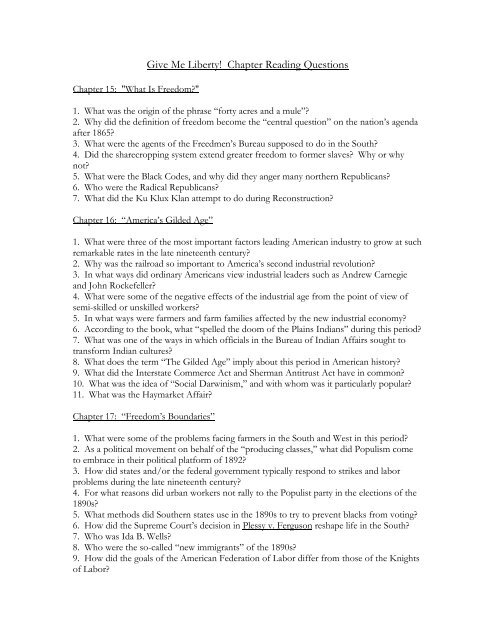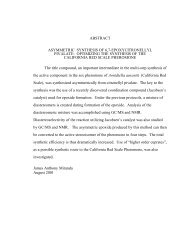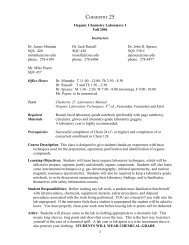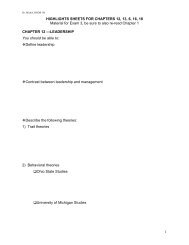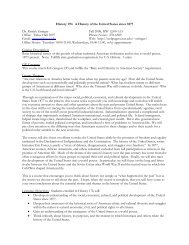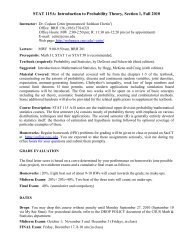Give Me Liberty! Chapter Reading Questions
Give Me Liberty! Chapter Reading Questions
Give Me Liberty! Chapter Reading Questions
Create successful ePaper yourself
Turn your PDF publications into a flip-book with our unique Google optimized e-Paper software.
<strong>Chapter</strong> 15: "What Is Freedom?"<strong>Give</strong> <strong>Me</strong> <strong>Liberty</strong>! <strong>Chapter</strong> <strong>Reading</strong> <strong>Questions</strong>1. What was the origin of the phrase “forty acres and a mule”?2. Why did the definition of freedom become the “central question” on the nation’s agendaafter 1865?3. What were the agents of the Freedmen’s Bureau supposed to do in the South?4. Did the sharecropping system extend greater freedom to former slaves? Why or whynot?5. What were the Black Codes, and why did they anger many northern Republicans?6. Who were the Radical Republicans?7. What did the Ku Klux Klan attempt to do during Reconstruction?<strong>Chapter</strong> 16: “America’s Gilded Age”1. What were three of the most important factors leading American industry to grow at suchremarkable rates in the late nineteenth century?2. Why was the railroad so important to America’s second industrial revolution?3. In what ways did ordinary Americans view industrial leaders such as Andrew Carnegieand John Rockefeller?4. What were some of the negative effects of the industrial age from the point of view ofsemi-skilled or unskilled workers?5. In what ways were farmers and farm families affected by the new industrial economy?6. According to the book, what “spelled the doom of the Plains Indians” during this period?7. What was one of the ways in which officials in the Bureau of Indian Affairs sought totransform Indian cultures?8. What does the term “The Gilded Age” imply about this period in American history?9. What did the Interstate Commerce Act and Sherman Antitrust Act have in common?10. What was the idea of “Social Darwinism,” and with whom was it particularly popular?11. What was the Haymarket Affair?<strong>Chapter</strong> 17: “Freedom’s Boundaries”1. What were some of the problems facing farmers in the South and West in this period?2. As a political movement on behalf of the “producing classes,” what did Populism cometo embrace in their political platform of 1892?3. How did states and/or the federal government typically respond to strikes and laborproblems during the late nineteenth century?4. For what reasons did urban workers not rally to the Populist party in the elections of the1890s?5. What methods did Southern states use in the 1890s to try to prevent blacks from voting?6. How did the Supreme Court’s decision in Plessy v. Ferguson reshape life in the South?7. Who was Ida B. Wells?8. Who were the so-called “new immigrants” of the 1890s?9. How did the goals of the American Federation of Labor differ from those of the Knightsof Labor?
10. What were two of the factors that contributed to America’s emergence as a world powerin the Spanish-American war?11. How did American advocates of imperialism justify the conquest of the Philippines?<strong>Chapter</strong> 18: “The Progressive Era”1. How does Foner define the “Progressive movement”?2. Who were two of the most important muckrakers of the era?3. What were some of the “new” consumer goods available to consumers by 1910?4. How were traditional gender roles changing in this era?5. What does the author mean when he suggests this was an era when the “chief restrictionsupon liberty” were economic, not political?6. What sorts of reforms did Progressives pursue at the state level?7. For what reason did Progressives establish “settlement houses” in urban areas?8. What sort of government action did reformers such as Jane Addams pursue to addressthe problems of the poor?9. What did the Supreme Court rule in Muller v. Oregon?10. In what ways did President Teddy Roosevelt accept expanded federal powers in order toensure the “common good”?<strong>Chapter</strong> 19: “Safe for Democracy”1. What role did President Roosevelt play in helping to ensure that Americans would createand control the Panama Canal?2. What was the “Roosevelt Corollary”?3. What were some of the groups in opposition to U.S. involvement in the First World War?4. Why did so many influential Progressives come to endorse American involvement in thewar?5. What did the Wilson administration do to help promote the war effort?6. What did the Espionage Act of 1917 do?7. How did the war affect attitudes toward immigrants and Americanization?8. How did black leader William Monroe Trotter regard American involvement in the FirstWorld War?9. To what does the Great Migration refer?<strong>Chapter</strong> 20: “From Business Culture to Great Depression”1. How did Americans’ spending habits change in the 1920s?2. What were the attributes of “welfare capitalism” as it developed in this era?3. How did “flappers” challenge traditional ideas about women?4. What was one of the important findings in the sociological study of Middletown?5. What changes came to American immigration law in the 1920s?6. To what does the Harlem Renaissance refer?7. What groups did the Ku Klux Klan begin to target in the 1920s?8. For what reason was John Scopes put on trial in 1925?9. How does the textbook characterize Herbert Hoover’s response to the GreatDepression?
<strong>Chapter</strong> 21: “The New Deal”1. Why did Franklin Roosevelt declare a federal banking holiday in spring 1933?2. What did the Glass-Steagall Act do to reform banking in the U.S.?3. What was the purpose of the National Recovery Administration?4. Why did section 7(a) of the National Industrial Recovery Act offer to labor unions?5. What was the purpose of the Agricultural Adjustment Act?6. What were the proposals of Huey Long?7. What did Francis Townsend propose as a solution to the depression economy?8. How did the successful organization of the Congress of Industrial Organizations changepolitics in the 1930s?9. In addition to old age pensions, what did the Social Security Act of 1935 create?10. How did the Great Depression help undermine organized feminism?11. How did the Great Depression affect the <strong>Me</strong>xican American community?<strong>Chapter</strong> 22: “Fighting for the Four Freedoms”1. What developments in the 1930s were leading toward global instability in Asia andEurope?2. How did the Nye committee feed the American spirit of isolationism in the 1930s?3. What were the purposes of the Neutrality Acts (1935-37)?4. What happened at Pearl Harbor?5. How was the West Coast transformed economically during the war?6. How did the war bring new opportunities to American women?7. What impact did Nazi racial ideology have upon American ideas about race?8. What was Franklin Roosevelt’s “Economic Bill of Rights”?9. What was the bracero program?10. What did Executive Order 9066 do?11. Who was A. Philip Randolph?12. Why did the Soviet Union come to dominate the Baltic states and Eastern Europe at theend of World War II?<strong>Chapter</strong> 23: “The United States and the Cold War”1. Who was George Kennan?2. What was the Truman Doctrine?3. What were the American motives for the Marshall Plan?4. What caused the “Berlin Crisis” of 1948?5. Using the map on page 784, identify four of the NATO countries in Europe.6. What did the federal government’s “Militant <strong>Liberty</strong>” program attempt to do?7. What caused the defection of southern “Dixiecrats” from the Democratic Party in 1948?8. What was the House UnAmerican Activities Committee?
<strong>Chapter</strong> 24: “An Affluent Society”1. What were some of the sources of economic growth in the 1950s?2. How does the textbook characterize television programming in the 1950s?3. According to the author, what was the aim of Eisenhower’s “Modern Republicanism”?4. What did the policy of “massive retaliation” refer to?5. How did decolonization affect Cold War tensions between the U.S. and Soviet Union?6. How did the Eisenhower administration respond to the launching of Sputnik in 1957?7. Who were the “beatniks,” and what were their criticisms of American life?8. What was the essential finding of Brown v. Board of Education?9. What was the Southern Manifesto?10. What did Eisenhower fear about the “military-industrial complex”?<strong>Chapter</strong> 25: “The Sixties”1. What were the “freedom rides” of 1961 designed to do?2. What important television images emerged from the Birmingham protests of 1963?3. What led to the Cuban Missile Crisis?4. What did the 1964 Civil Rights Act do?5. How did the Immigration Act of 1965 change American immigration law?6. What were the key elements of Johnson’s Great Society reforms of 1965-67?7. What did the book The Other America reveal about American society?8. To whom does the term New Left refer?9. What did the Gulf of Tonkin Resolution authorize?10. What were some attributes of the youth counterculture that emerged in the 1960s?11. What was the significance of the 1963 publication of The Feminine Mystique?12. What did the Supreme Court’s 1967 decision in Loving v. Virginia do?13. What was the Tet offensive?


